-

人音版小学音乐一年级上音的长短说课稿
第五个环节:最后播放一段音画视频,儿童舞蹈《数鸭子》,让全体同学跟着音乐哼唱儿歌,让她们感觉回到了自己的童年时代。让学生即兴创编舞蹈动作,并上台表演。这样,使学生在律动中获得身心愉悦,把整节课堂气氛推向了高潮。并在欢乐的歌舞声中结束。接下来说说我的作业布置情况: 1、知识巩固性的作业,做练习题书中P37页第一题,第二题。2、拓展性作业,收集儿歌《》《》《》并找出音符在其乐曲中的长短。七、板书设计(一)黑板中央上方写上题目——音的长短。(二)左上方依次写下单纯音符、几种常见音符及其形状。(三)画出各音符之间的时值比例关系图。(四)右边画出音符及其时值和单位拍的对照表。八、教学反思最后我就说说教学反思,本节课的教学围绕着学生想、听、唱、跳这样的动作层层推进。调动了学生的学习热情,关注学生的个性发展。激发了学生学习音乐的兴趣,增强她们的基本技能,为以后从事幼教工作打下坚定的基础。最后以一句歌词,来结束我的说课。

人音版小学音乐一年级上跳舞的洋娃娃说课稿
乐曲是三部曲式,D大调,3/8拍,快板。乐曲开始是一个短小的引子,由钢琴演奏。前面的5小节之后,小提琴从弱拍进入,用弹跳式的弓法演奏,由这里开始的一系列16分音符和8分音符,都加有顿音记号,取得了绝妙的效果,把洋娃娃那可爱、活泼,又有几分笨拙、机械的动作描绘得活灵活现。B段转A大调。曲调优美、婉转,在性格上它与A段形成鲜明的对比。后半部分在调性上做文章,使乐曲产生了色彩斑斓的效果:然后A段再现,最后轻快地结束全曲。学生会很喜欢这首小曲,从中感受小提琴的音色,感受乐曲活泼欢快与优美抒情的对比。 聆听《会跳舞的洋娃娃》教学基本要求1.完整聆听乐曲,感受乐曲的情绪。2.乐曲是由什么乐器演奏的?乐曲的洋娃娃怎样跳舞,请你用动作表现出来。3.复听乐曲,一部分同学随着音乐做动作。用手半握拳敲击节拍。一部分学生可随着音乐用手指按图谱划动,感受乐曲的快慢。

人音版小学音乐四年级上中华人民共和国国歌说课稿
2)、配乐朗诵,整体感知。要进一步了解国歌就要学习国歌的歌词,因此我以管弦乐《中国人民共和国国歌》为背景音乐有节奏地带领学生有感情地朗读歌词,让学生小组讨论探讨国歌表达的内容,加深学生对国歌的了解,让学生明白国歌的重要意义,加深学生的情感体验。3)、听赏齐唱歌曲《中华人民共和国国歌》。聆听是一切音乐实践活动赖以进行的基础,因此我让学生听赏齐唱歌曲《中华人民共和国国歌》,提出聆听要求:歌曲可以分为几部分?每部分可以划分为几个乐句?说一说为什么要这样划分。分组讨论,再小组汇报。通过这部分的聆听学习,小组讨论,发挥了学生的团结合作能力和学习的主动性,把歌曲划分为两部分,第一部分是引子,第二部分由四个乐句组成。
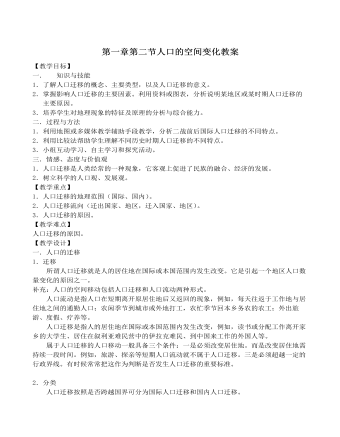
人教版新课标高中地理必修2第一章第二节人口的空间变化教案
1.促使美国成为一个移民国家的因素是:①美洲属于未开发的新大陆,需要大量的劳动力;②欧洲失业工人和破产农民增加,人们为了追求更好的经济待遇迁往美洲;③新航线的开辟为人们顺利迁移扫除了障碍;④殖民扩张是人口迁移的促进因素,加快了人口迁移的过程。导致美国人口在本土范围内频繁迁移的原因,归纳起来有:第一次人口迁移是战争因素,第二次是城市化;第三次是自然环境、经济环境的变化;第四次是经济格局的变化,即西部和南部新资源的发现和新兴工业的发展。2.我国古代的人口迁移,深受统治者及其行政力量的束缚。封建帝王为了加强本国的经济和军事实力,对人口迁移严加控制。只有当战乱发生的时候,这种控制才得到削弱,人们为了躲避战乱,寻找安定的生活环境,不得不进行大规模的迁移。我国近几十年的人口迁移主要是由生产资料和劳动力数量上的地区分布不平衡造成的,是经济因素在起主导作用,与古代的人口迁移截然不同。
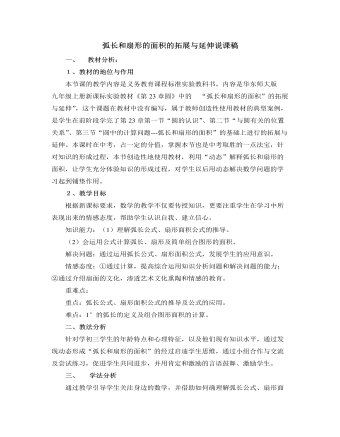
北师大版初中数学九年级下册弧长和扇形的面积的拓展与延伸说课稿
五、教学反思:时钟的秒针、分针、时针扫的图形, 汽车挡风玻璃的刮水器;刷工人刷过的面积近似看为扇形。圆中的计算问题---弧长和扇形的面积,虽然新课标、新教材要求学习,但本节教师结合学生的实际要求,将其作为内容进行拓展与延伸,具有一定的实际意义。用生活中动态几何解释扇形,体验解决问题策略的多样性,发展实践能力与创新精神。本节课,教师通过“扇子”的问题情景引入新课,它蕴含了大量的情感信息,有效激发学生的求知欲望,充分调动学生的学习积极性,注重学生的参与,让出时间与空间由学生动手实践,鼓励学生自主探索、合作交流、展示成果,提高了学生发现问题、提出问题、解决问题的能力。用“扇子变化”,帮助学生探索自然界中事物的动静结合问题,利用“扇子的文化”的新奇感激起学生的学习热情,陶冶了学生的学习情操,从而使学生更深切地理解问题,使原本单调枯燥的数学变得生动、形象,激发学生的情感,使课堂充满生机。
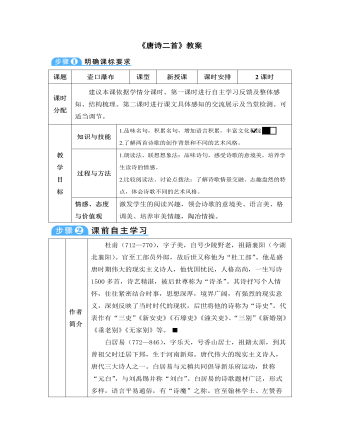
部编版语文八年级下册《唐诗二首》教案
761年8月,成都平原风雨成灾。草堂被吹破了,草堂前的一棵200年的楠树也被拔倒了。〖JP3就在诗人政治上受到冷遇,又加风雨成灾的情况下,杜甫写了《茅屋为秋风所破歌》。〖JP《卖炭翁》:本诗选自《白居易集》卷四(中华书局1979年版)。本诗是白居易《新乐府》组诗中的第三十二首,自注云:“《卖炭翁》,苦宫市也。”白居易写作《新乐府》是在元和(唐宪宗年号,806—820)初年,这正是宫市为害最深的时候。他对宫市十分的了解,又对人民有深切的同情,所以才能写出这首感人至深的《卖炭翁》来。皇宫所需的物品,本来由官吏采买。中唐时期,宦官专权,横行无忌,连这种采购权也抓了过去,常有数十百人分布在长安东西两市及热闹街坊,以低价强购货物,甚至不给分文,还勒索“进奉”的“门户钱”及“脚价钱”。名为“宫市”,实际是一种公开的掠夺。诗人有感于此,写下本诗。
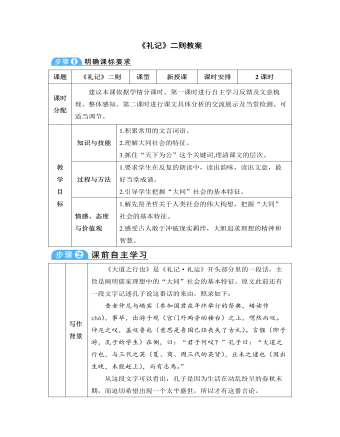
部编版语文八年级下册《礼记》二则教案
【课堂讨论,拓展延伸】1.文中“大同”社会跟陶渊明描绘的那个“世外桃源”有没有相似的地方?2.请说一段话描绘你心目中的理想社会。这是两道开放性的题目。第一题,要启发学生透过“桃源”中的生活现象来认识这个社会,例如从“黄发垂髫,并怡然自乐”中可以看出“桃源”中的老人和孩子生活极其幸福、快乐,这就是“大同”社会中“老有所终”“幼有所长”,由此还可以推知矜、寡、孤、独、废疾者这五种人同样受到全社会的关爱。第二题重在激发学生进行大胆新奇的联想和想象,营造一种畅游理想未来的热烈气氛。【把握文章主旨】仔细阅读课文,理解文章主旨。《虽有嘉肴》:本文论述了教与学的关系问题,说明了教和学是相辅相成的,是互相促进的道理。《大道之行也》:本文通过对理想中的社会特征的描述,阐明了儒家理想中的“大同”社会的基本特征,表达了作者对这个理想社会的向往,同时,也反映了我国古代劳动人民对美好生活的追求。
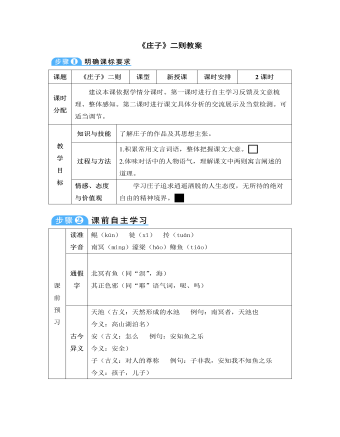
部编版语文八年级下册《庄子》二则教案
【再读课文,梳理结构】1. 文章标题为“北冥有鱼”,后来怎么又写鸟了?鸟是由鱼变化而来的。鲲的体形有几千里,变成鸟后,鸟的脊背不知有几千里长。说明庄子想象力丰富。2. 鸟为什么要迁徙到南冥?南冥是天人的大池,是鸟心目中的理想境地,是要追求一种精神的自由。3. 鲲鹏由北海飞到南海,需要借助什么条件?“海运则将徙于南冥”“抟扶摇而上者九万里,去以六月息者也”4. 句子赏析:“鹏之徙于南冥也,水击三千里,抟扶摇而上者九万里。”词句运用丰富的想象,奇特的夸张,描写了鲲鹏振翼拍水,盘旋飞向九万里高空的形象,这一形象能激发人的豪情壮志,具有强烈的艺术感染力。“击”“抟”等字传神、生动,让人产生丰富的想象和联想。
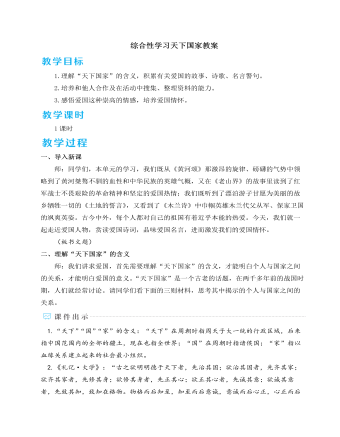
人教部编版七年级下册综合性学习天下国家教案
我荣幸地以中华民族一员的资格,而成为世界公民。我是中国人民的儿子。我深情地爱着我的祖国和人民。 ——邓小平一个人只要热爱自己的祖国,有一颗爱国之心,就什么事情都能解决。什么苦楚,什么冤屈都受得了。 ——冰心做人最大的事情是什么呢?就是要知道怎么样爱国。 ——孙中山能够献身于自己祖国的事业,为实现理想而斗争,这是最光荣不过的事情了。——吴玉章外国爱国名言示例:我们为祖国服务,也不能都采用同一方式,每个人应该按照资禀,各尽所能。——歌德纵使世界给我珍宝和荣誉,我也不愿离开我的祖国。因为纵使我的祖国在耻辱之中,我还是喜欢、热爱、祝福我的祖国。 ——裴多菲我重视祖国的利益,甚于自己的生命和我所珍爱的儿女。 ——莎士比亚我无论做什么,始终在想着,只要我的精力允许我的话,我就要首先为我的祖国服务。 ——巴甫洛夫

人教版新目标初中英语七年级下册Where is the post office教案2篇
Period 2 (3a----Section B 2c)Preview(Pre-task): Key points: What laAdd another information about their pen pals----their language on the cardnguage does she/he speak?She/He speaks....Does she/he have any brothers and sisters? Does she/he speak English?Preview(Pre-task): Add another information about their pen pals----their language on the cardKey points: What language does she/he speak?She/He speaks....Does she/he have any brothers and sisters? Does she/he speak English?Step 1 Revision1.Revisionand dictation of the new words 2.Revise the drills they learned yesterday.(by pairwork and grammar exercise)Step 2 Leading-inT has a conversation with one student. The conversation is following:---Do you have a pen pal?---Yes, I do.---What's your pen pal's name? ---His/Her name is....---Where is your pen pal from? ---He/She is from...---Where does he/she live? ---He/She lives in....---What language does he/she speak?He/She speaks...Write the new words on the Bb. They are following: EnglishChineseJapaneseFrenchStep 3 LearnLearn the new words with the whole class.Finish 3a with the students3b Pairwork T still does an example with one student Then the Ss practise in pairs. The example is following:--Curry Muray is my pen pal. He is from the United States.---What language does he speak?

人教版新目标初中英语八年级下册Have you ever been to an amusement park教案
(1)Have you ever been to …? Yes, I have. / Yes, I have ever been to …No, I haven’t. / No, I have never been to …(2)When did you go there? I went there last year. (3)I have never been to a water park. Neither have I. I have ever been to an amusement park. So have I. (4)How long have you been studying English? I’ve been studying English since nine o’clock. I’ve been studying English since I came back home. I’ve been studying English for five hours. (5)What’s that? It’s an amusement park in Japan. I’ve never been to an amusement park like it before. It’s fun to learn another language. Let’s go tonight. Isn’t this great?space museum, amusement park, water park, South America, Peru, Holland, European culture, tour guide, flight attendant, musical instrument, more than, be from, get to, take lessons, neither, discover, graduate, change

人教版新目标初中英语八年级下册It’s a nice day, isn’t it教案2篇
"Hello! Welcome to English class! Introduce yourself. Meet your new classmates." That's what the teacher says. What do you say? "Oh no!" It can be difficult talking to new people. But it can be fun, and you can make friends. How do you do it? Make small talk. Small talk is polite conversation. "Wang Nan is a great pingpang player, isn't she?" "I'd love to meet her, wouldn't you?" "It's been raining a lot, hasn't it?" Tag questions are a form of polite speech. To make small talk successfully, you should know how to make them. You should also know what topics to talk about. Try to learn this unit carefully. The next time you're in English class, you'll find out. Making small talk's easy, isn't it? (“你好!欢迎你!请做一下自我介绍。认识一下你的新同学。”通常在课上老师会这样说。你会说什么呢?“噢,不!”与陌生人谈话太困难了。但是这也很有意思,并且你还能交到朋友。你该怎么做呢?闲聊。闲聊指得是礼貌的对话。“王楠是一个很棒的乒乓球运动员,不是吗?”“我希望自己能认识她,你呢?“今年的雨水很多,不是吗?”反意疑问句是一种礼貌用语。为了使得谈话成功,你应该知道怎样去进行闲聊。你还应该知道与不同的人该谈论什么样的话题。认真的学习这个单元吧,下次在英语课上,你会发现与大家展开谈话是一件很容易的事情,不信我们来试试。)

人教版新目标初中英语七年级下册I ’d like some noodles教案
教学过程Step 1: warming-up Sing a song---------“food and drink” Step 2: Revision1 Dictation2 Revise: What kind of noodles would you like?I’d like …What size bowl of noodles would you like?I’d like…Step 3: Presentation1 show pictures of food, ask students say the words.2 Students read the newspaper ad in 3a. Fill in blanks with words in the box. Then read the ad together, the teacher explains some difficult language points.3 Check the answers Step 4 PracticeAsk students to finish 3b in the same way according to 3a. Students read the short passage and fill in the blanks .At last, check the answers.Step 5 productionAsk students to write their own ad for dumplings, noodles, drinks, and other foods they know. Then ask students to read their partner’s ad. Then order food and drink from their partner.Step 6 Home workGroup work – make an ad about “food and drink”

人教版新目标初中英语七年级下册I want to be an actor教案2篇
三、教学建议第一课时:1. Lead in (Vocabulary)A) Before class, teacher should collect some pictures of working places. For example: Bank, TV Station, Restaurant, Police Station, Hospital ...B) In class, show students the pictures (PowerPoint, OHP). Ask students to tell the name of the working places and the name of the jobs.Shop assistant, doctor, actor, reporter, police office, waiter, bank clerk, studentC) Do exercise 1a and 3a.2. Bingo GameAsk groups of students to make up pairs of cards with a job on one and the related workplace on the other. For example, waiter / restaurant, teacher / school, doctor / hospital. Encourage students to use both the job / workplace combinations in the book and the ones that students came up during class discussions. Be sure they have twice as many sets of cards as there are students in the group. They can make two sets of cards for a single job / workplace, if necessary. Then have each group mix up its set of cards and hand their cards out in random order. Each time a student gets a pair of cards that match, he or she can lay these cards down. The goal is to have no cards in your hand at the end.3. Task OneA) Ask students to work in pairs and ask the partner what does he / she want to be in the future.e. g. :What do you / does he / does she want to be?I want to be a.Why?Because it's (adj).B) Vocabulary: Section B, 1a4. Homework 1.2.

人教版新目标初中英语七年级下册What do you think of game shows教案
五、教学Section B-2c1. Pair work: What do you think of the belt/sunglasses/…? What does your father/mother/… think of your scarf/belt…?2. Group work(1). Teacher shows some different kinds of school uniforms (制服)and asks : “ What do you think of your school uniforms? If you have a chance to choose your school uniforms, what kind would you like to choose?”(2). Discuss in groups.(3).Get some Ss to report in class.说明:这一步旨在让学生运用已有的语言知识谈论对事物的看法和意见,并简单阐明理由,培养学生的主动思维能力和运用英语的能力。六、教学拓展调查电视节目的收视率任务:调查你周围的人对现在各种电视节目的反响。活动过程:1.教师布置任务,让学生调查周围的人(包括他的亲戚朋友和邻居)喜欢收看哪方面的电视节目。2.学生进行调查活动,运用本单元所学的句型What do you think of….? (Why?)What's your favorite game shows?What do you think of talk show?I doesn’t mind it.I like it.I love it.I can’t stand it.3.记录下排在前10位的TV Program,填写调查表,比较其收视率。

人教版新目标初中英语七年级下册Where did you go on vacation教案
句型: Where did you go on vacation? I went to summer camp.Did she go to Central Park?Yes,she did.No, she didn’t语法:一般过去时特殊疑问句、一般疑问句及肯、否定回答。课时安排4课时第一课时:Section A:la,1b,lc,2a,2b,2c 第二课时:Section A:3a,3b,4第三课时:Section B:1,2a,2b,2c第四课时:Section B:3a,3b,3c,4 and Self Check第一课时教学目标掌握描写假期生活的形容词。假期里自己所做事情的简单表达。谈论假期做的事情及当时情况。谈论假期时旅游的天气,旅游者以及食物等。教学过程一、导入播放一首英文歌曲:Let’s travel 说明:通过让学生听节奏欢快迪斯尼英语歌曲Let’s travel.引入本节课谈论的话题vacation and travel. 让歌曲使学生的思维活跃,增强课堂气氛,激发学生提高学习英语的兴趣。T:How is the trip ?Ss : It’s pretty good/ happy/exciting /relaxing/busy/dangerous/ fantastic说明:这个问题是为了操练形容词。建议让多个Ss作答。鼓励他们用不同的形容词。上述个别形容词本应在第二课时中出现,但可以在warming-up中第一次非正式出现。这些形容词也可在老师的评价语中适时出现,以加深学生对词汇的印象。

人教版新目标初中英语八年级下册What should I do教案2篇
说明:在帮Li Lei提建议的同时,教育学生如何学好英语。第三课时教学目标1. 语言目标:a) 词汇: Original, in style, haircut, the same as.b) 语言结构:My friend wears the same clothes and has the same haircut as I do.2. 能力目标:大多数学生能够谈论自己喜欢哪种服装,提高查找信息的能力。3. 情感目标:学会如何与朋友相处,要有自己对时尚的看法。教学重点掌握一些重要词汇。教学难点学会谈论问题,并能提出书面建议。◆教学突破首先针对Erin的问题,提出个人的建议,模仿2c部分的对话展开双人交际Pair-work;听老师诵读3a部分的信件,并找出LEFT OUT的问题所在;学生完成3b部分的内容,给Left Out提出书面的建议;学以口头形式提出自己目前存在的某个问题,讲给大家听,让同学们给自己提出一个建议,并作笔录;学生两、三个人分成一组,随意性地进行口语交际,谈论P14的第4部分的某个问题,相互交换意见。

人教版新目标初中英语八年级下册He said I was hard-working教案2篇
This activity introduces some new vocabulary and provide oral practice using the target language.Task 1 . Ask four students to stand in front of the class, and the teacher asks them the following questions as a reporter.1.What are you going to do when you grow up?2.What are you going to do next week?3.What are going to do after school?The students will give different answers, then ask a good student to report what they said.I am going to e a doctor.What did she say?----------She said she was going to be a doctor.I am going to have a party on Friday night.What did he say?-------He said he was going to have a party on Friday night.I am going to do my homework.What did she say ?------ She said she was going to do her homework.I am going home after school.What did she say?-----She said she was going home after school.Say In this unit we are going to learn to use words like to report what someone said.Task 2. Read the instructions. Then ask a student to read the four questions. And write the words on the Bb. Explain what soap opera is.Task 3. Ask the students to Look at the pictures, point out the TV screens in the picture. Ask one girl to read what Marcia said.What did Marcia say? She said She said she was having a surprise party for Lana on Friday night. Repeat the other pictures in the same way.Activity3. Listen and number the pictures in activity 1a.

人教版新目标初中英语七年级下册How was your weekend教案2篇
Teaching Goal:1. General aims:Talk about recent past events2. Particular aims:A. Language Focus.Talk about recent past events and think of the past events.B. Language goalsHow was….?It was …What did …do over the weekend?C. Language structures:(1). How was your weekend? I was great. Pay attention to no form.(2). What did you do over the weekend? I played soccer. We went to the beach.D. Useful words and phrases:Words: was, did, went, beach, over, project, test, wasn’t, false, number, geography, spend, week, most, mixture, their, had, little, cook, read, saw, change, everyone, sit, sat, no, anythingPhrases: did one’s homework, played soccer, cleaned my room, went to the beach, played tennis, went to the movies, on Saturday morning, over the weekend, cook … for, what about, do some reading, have a party, talk show, go shoppingE. Grammar language:Present simple past tenseRegular and irregular verbsF. Learning strategies:Tour and holidaysG. Interdiscipinary:H. Emotion and manner:Teaching time: 5 periodsTeaching procedures:Period One教学步骤、时间 教师活动 学生活动 媒体应用Step 1Free talk 3’ Ask some questions like:Who’s on duty today?What’s the weather like? Answer and talk about something.让同学们回答下列问题1. Do you like weekend? (Let some students answer)It takes them three minutes to talk about the question.2. Why do you like weekend? (let the students answer) Most of the students like the weekend此时教师用汉语问:“在周末期间问你干了什么?这句话用英语这么回答?Let the students guess.At last the teacher give them right answer3. What did you do over the weekend?(板书、学习)

人教版新目标初中英语七年级下册What does he look like教案3篇
所需要用到的句子:Who is that?That is Jack. I like him.Why do you like him?I like him because he is interesting.Task 4: 设计理想中的人类Step one: 设计理想中的人类的外貌。把全班同学分成若干小组,学生可以边说边在纸上画出他们的模样。Step two: 设计理想中人类的性格。学生们可以把那些能描述性格的单词写在图画的旁边。Step three: 每组选出一名同学,其他同组同学提问,他作简单回答,并说明原因。所需用到的句子:What does he or she look like?He or she ...What is he or she like?He or she is ...Why?Because ...Task 5: 挑战性活动调查性格是天生的还是后天形成的,让每个同学回家去调查一下自己成长过程中性格是否有变化,具体是怎样的,为什么会这样? Teaching Aims:1. Enable students to have a general understanding of how to talk about people's physical appearance.2. Enable students to tackle some essential vocabularies and patterns about describing people. Provide them with necessary skills and methods.3. Create various chances for students to describe the persons they're familiar with, such as classmates, family members, teachers, idols, etc.
